Four Great Films That Abandon The Four Second Rule
Share with friends
“The ‘MTV style’ of quick cuts and whipsaw cameras—known among veteran film editors as ‘frame-fucking’—is now the de facto visual language of American culture..."
Ever notice how many different angles are incorporated in a single movie scene? Generally, you have one camera positioned on the left of the actor, another on the right, and a wide shot of the whole set. An editor selects amongst these angles to create a single visual narrative. Recently TV shows, movies, commercials adhere to the so-called "four-second rule." It's known as the “MTV style” of video editing: the angle must change every four seconds or the audience gets bored.
As New York Magazine writer Ben Mathis-Lilley so eloquently says, “The ‘MTV style’ of quick cuts and whipsaw cameras—known among veteran film editors as ‘frame-fucking’—is now the de facto visual language of American culture, from Michael Bay summer blockbusters to commercials for Sunny Delight.”
But art always manages to find a way. These four movies prove that you can break from ADD editing and still succeed.
1. Once Upon a Time in Anatolia (2012)
A group of three cars roam the rural Turkish countryside through the night in search for a dead man’s body. In the cars we have a doctor, a policeman, a prosecutor, gravediggers, gendarmerie forces, and two brothers who are the suspects of the murder case. Kenan, the more mentally stable brother, recalls burying the body near a stream that leads out from a well. But there are so many wells in Turkey that the description is not much to go by. Tensions in the group are high and sugar levels are low so most of the men are grouchy and irritable. Once Upon a Time in Anatolia does not include a million different angles and it does not jump cut every few seconds. Part of the reason for that is that our fugitive is already caught - all that is left to do is find the body of the victim.
The film moves at a real time pace and includes every detail of pedestrian life in Turkey. It is interminably slow, but you can't help but be mesmerized. A majority of the shots are taken from a distance so that the viewer experiences a feeling of omnipresence. We are uninvited guests looking in as the case unfolds. The conversations between characters seem so light hearted and trivial that you feel as though you have been transported into the tightly packed car.
In one scene, a full two minutes is dedicated to a rotting apple falling from a tree and rolling downwards into a stream. Prior to that scene, we see the men at an unfruitful stop at yet another well, which happens to have an apple tree nearby. While one-man scrambles to collect all the fallen apples, a fresh, un-bruised apple falls and rolls downwards. As the camera focuses on the arduous journey of the apple, we hear a muffled conversation between two other men. The apple ends up rolling into a stream where the water takes it to area where five or six rotten apples have grouped up.
The journey of the apple represents the journey of life. No matter which route you take, everyone comes to the same end-point. The scene feels incredibly long. The director muffles the side conversation so we will focus on the apple.
2. A Streetcar Named Desire (1951)
The story of Blanche DuBois who goes to live with her younger sister and her brother-in-law in New Orleans after a personal loss. Blanche butts heads with Stanley Kowalski, her brother-in-law, played by Marlon Brando. Stanley is a very crude, physical, and abusive man, while Blanche is a well-kept southern lady. Stanley ends up raping Blanche and when Blanche tries to tell her sister, she is deemed crazy and sent to a mental ward.
The film uses the 180-degree rule that is characteristic of the classical Hollywood narrative format. The camera is kept on the same side of the action at all times. This is evident in the scene where Blanche and her sister come back from a girl’s night out and head to the back-room, while the men are playing cards. The shot is kept at one angle for the entire scene. The camera moves to follow Blanche and her sister as they talk and giggle amongst themselves. For the most part, this camera movement is uninterrupted up until the girls are forced to interact with the men playing cards.
The MTV style uses music and editing to help set a mood. A Streetcar Named Desire uses doesn't rely on such tricks. In fact, in one scene Blanche opens up the radio for five seconds before Stanley angrily barges in and slams the radio shut. In this case, the lack of music is what creates tension between the two individuals.
Conversations between characters generally happen on the same screen. We do not see jump cuts of close ups of individuals when they are speaking.
3. Breakfast at Tiffany’s (1961)
A romantic comedy that follows the life of Holly Golightly played by Audrey Hepburn. It's perfectly edited with techniques that go far above and beyond the four second rule.
A technique that editor Howard A. Smith uses is the eyeline match. Eyeline matching is when the audience sees what the character on-screen is seeing. When Holly is talking to Paul Varjack about his book Nine Lives as he is laying in bed, the camera is positioned so that the audience is viewing Holly at the same angle as Paul is.
Another technique that Smith uses is the match-on-action shot. This is when the editor cuts from one shot to another view that matches the first shot’s action. By having an action completed in multiple shots, it forms a visual bridge, which creates an illusion of continuity. In that same scene mentioned above, this technique is used when Holly mentions that Paul reminds her of her brother Fred. There is a subtle change in the shot the moment Holly sits on the bed. It's difficult to notice, because it's so seamlessly incorporated.
4. Stranger Than Paradise (1984)
Stranger than Paradise is a deadpan/absurdist comedy film written and directed by Jim Jarmusch that has a minimalist plot. The film is about Willie (John Lurie) who lives in New York City and whose cousin, Eva (Eszter Balint), visits from Hungary to stay with him for ten days. Initially, Willie does not like Eva, but during those ten days, he ends up enjoying her company. She flies out to Cleveland and, a year later, after winning a large sum of money by cheating at a game of poker, Willie and his friend, Eddie, go to Cleveland to visit Eva. Eva, Willie, and Eddie end up flying down to Florida where they experience a series of absurd events.
With MTV editing there is more of an emphasis on character development than there is on plot. In Stranger than Paradise, the plot is the focus. There is emphasis on the series of events that the characters go through. The film uses tight spatial and temporal constrictions. This use of space is seen in the first scene where Willie and Eva interact. The camera is kept on one side of the room the entire time.
Nearly every action is recorded in a single shot. There are no cuts in the middle of a scene, which adds an even greater sense of continuity. In most scenes, the camera angle does not change and there are rarely any close-ups.




